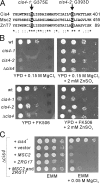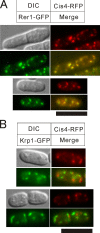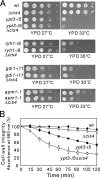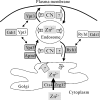Cation diffusion facilitator Cis4 is implicated in Golgi membrane trafficking via regulating zinc homeostasis in fission yeast
- PMID: 18199682
- PMCID: PMC2291430
- DOI: 10.1091/mbc.e07-08-0805
Cation diffusion facilitator Cis4 is implicated in Golgi membrane trafficking via regulating zinc homeostasis in fission yeast
Abstract
We screened for mutations that confer sensitivities to the calcineurin inhibitor FK506 and to a high concentration of MgCl(2) and isolated the cis4-1 mutant, an allele of the gene encoding a cation diffusion facilitator (CDF) protein that is structurally related to zinc transporters. Consistently, the addition of extracellular Zn(2+) suppressed the phenotypes of the cis4 mutant cells. The cis4 mutants and the mutant cells of another CDF-encoding gene SPBC16E9.14c (we named zrg17(+)) shared common and nonadditive zinc-suppressible phenotypes, and Cis4 and Zrg17 physically interacted. Cis4 localized at the cis-Golgi, suggesting that Cis4 is responsible for Zn(2+) uptake to the cis-Golgi. The cis4 mutant cells showed phenotypes such as weak cell wall and decreased acid phosphatase secretion that are thought to be resulting from impaired membrane trafficking. In addition, the cis4 deletion cells showed synthetic growth defects with all the four membrane-trafficking mutants tested, namely ypt3-i5, ryh1-i6, gdi1-i11, and apm1-1. Interestingly, the addition of extracellular Zn(2+) significantly suppressed the phenotypes of the ypt3-i5 and apm1-1 mutant cells. These results suggest that Cis4 forms a heteromeric functional complex with Zrg17 and that Cis4 is implicated in Golgi membrane trafficking through the regulation of zinc homeostasis in fission yeast.
Figures








Similar articles
-
Studies on the roles of clathrin-mediated membrane trafficking and zinc transporter Cis4 in the transport of GPI-anchored proteins in fission yeast.PLoS One. 2012;7(7):e41946. doi: 10.1371/journal.pone.0041946. Epub 2012 Jul 25. PLoS One. 2012. PMID: 22848669 Free PMC article.
-
Zinc transporters belonging to the Cation Diffusion Facilitator (CDF) family have complementary roles in transporting zinc out of the cytosol.PLoS Genet. 2018 Mar 12;14(3):e1007262. doi: 10.1371/journal.pgen.1007262. eCollection 2018 Mar. PLoS Genet. 2018. PMID: 29529046 Free PMC article.
-
Genetic and functional interaction between Ryh1 and Ypt3: two Rab GTPases that function in S. pombe secretory pathway.Genes Cells. 2006 Mar;11(3):207-21. doi: 10.1111/j.1365-2443.2006.00935.x. Genes Cells. 2006. PMID: 16483310
-
Eukaryotic zinc transporters and their regulation.Biometals. 2001 Sep-Dec;14(3-4):251-70. doi: 10.1023/a:1012988914300. Biometals. 2001. PMID: 11831460 Review.
-
A structural overview of the zinc transporters in the cation diffusion facilitator family.Acta Crystallogr D Struct Biol. 2019 Apr 1;75(Pt 4):357-367. doi: 10.1107/S2059798319003814. Epub 2019 Apr 5. Acta Crystallogr D Struct Biol. 2019. PMID: 30988253 Free PMC article. Review.
Cited by
-
Zinc homeostasis in the secretory pathway in yeast.Curr Opin Chem Biol. 2020 Apr;55:145-150. doi: 10.1016/j.cbpa.2020.01.011. Epub 2020 Feb 27. Curr Opin Chem Biol. 2020. PMID: 32114317 Free PMC article. Review.
-
Zinc homeostasis in Schizosaccharomyces pombe.Arch Microbiol. 2023 Mar 21;205(4):126. doi: 10.1007/s00203-023-03473-4. Arch Microbiol. 2023. PMID: 36943461 Review.
-
NADPH-Cytochrome P450 Reductase Ccr1 Is a Target of Tamoxifen and Participates in Its Antifungal Activity via Regulating Cell Wall Integrity in Fission Yeast.Antimicrob Agents Chemother. 2020 Aug 20;64(9):e00079-20. doi: 10.1128/AAC.00079-20. Print 2020 Aug 20. Antimicrob Agents Chemother. 2020. PMID: 32571823 Free PMC article.
-
E3 ubiquitin ligase Pub1 is implicated in endocytosis of a GPI-anchored protein Ecm33 in fission yeast.PLoS One. 2014 Jan 14;9(1):e85238. doi: 10.1371/journal.pone.0085238. eCollection 2014. PLoS One. 2014. PMID: 24454826 Free PMC article.
-
Phosphoinositide-Dependent Protein Kinases Regulate Cell Cycle Progression Through the SAD Kinase Cdr2 in Fission Yeast.Front Microbiol. 2022 Jan 10;12:807148. doi: 10.3389/fmicb.2021.807148. eCollection 2021. Front Microbiol. 2022. PMID: 35082773 Free PMC article.
References
-
- Beach D., Piper M., Nurse P. Construction of a Schizosaccharomyces pombe gene bank in a yeast bacterial shuttle vector and its use to isolate genes by complementation. Mol. Gen. Genet. 1982;187:326–329. - PubMed
-
- Borrelly G. P., Harrison M. D., Robinson A. K., Cox S. G., Robinson N. J., Whitehall S. K. Surplus zinc is handled by Zym1 metallothionein and Zhf endoplasmic reticulum transporter in Schizosaccharomyces pombe. J. Biol. Chem. 2002;277:30394–30400. - PubMed
-
- Clemens S., Bloss T., Vess C., Neumann D., Nies D. H., Zur N. U. A transporter in the endoplasmic reticulum of Schizosaccharomyces pombe cells mediates zinc storage and differentially affects transition metal tolerance. J. Biol. Chem. 2002;277:18215–18221. - PubMed
Publication types
MeSH terms
Substances
LinkOut - more resources
Full Text Sources
Molecular Biology Databases
Miscellaneous

